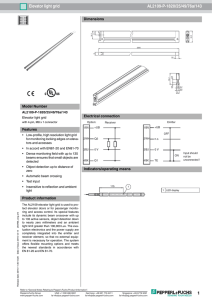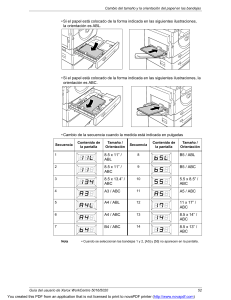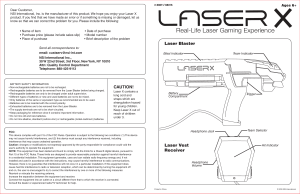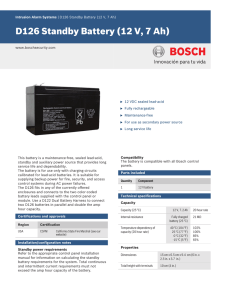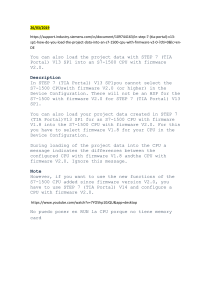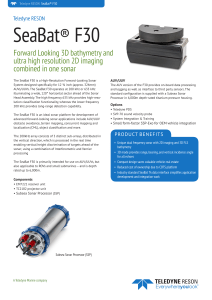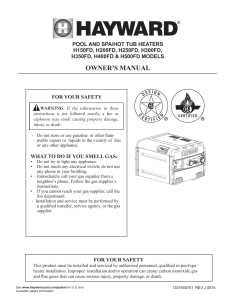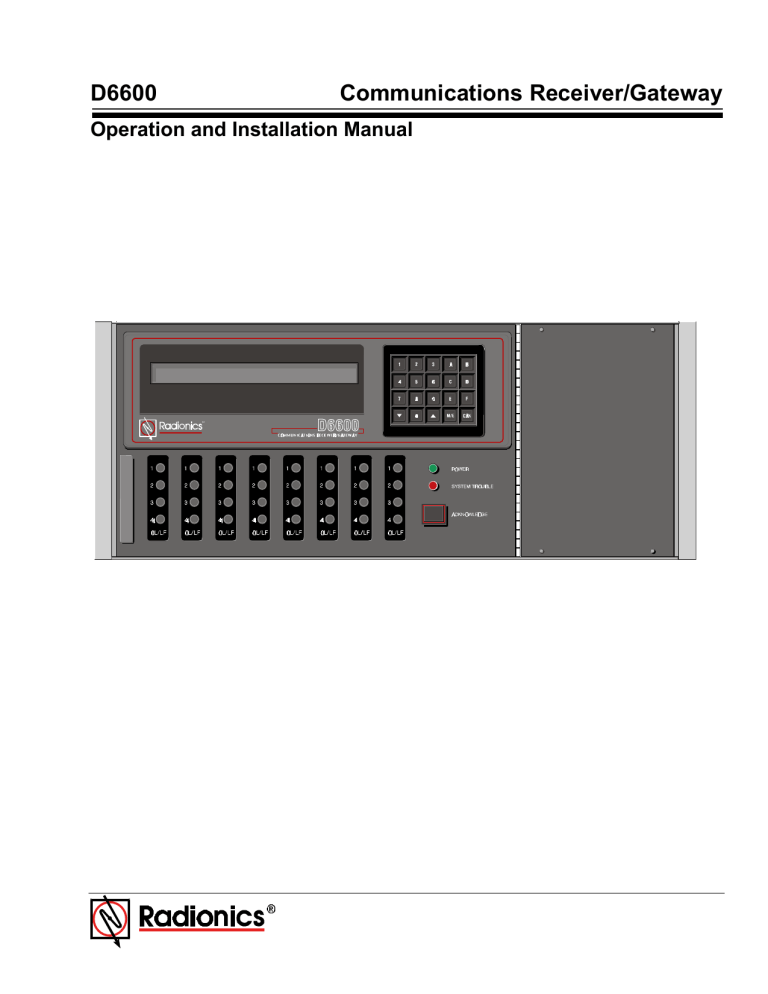
D6600 Communications Receiver/Gateway Operation and Installation Manual D6600 Contents 1.0 2.0 3.0 4.0 5.0 6.0 7.0 8.0 9.0 10.0 11.0 12.0 13.0 14.0 15.0 16.0 17.0 18.0 19.0 20.0 Introduction ................................................................................................... 3 Emergency Procedures ................................................................................ 4 Specifications ................................................................................................ 5 Card Functions and Locations ...................................................................... 7 D6640 Line Card and D6645 Line Terminator Card..................................... 9 D6610 CPU Card and D6615 CPU Terminator Card ................................. 10 Power Supply Modules ............................................................................... 11 Printer Specifications .................................................................................. 12 Installation ................................................................................................... 13 Standby Power............................................................................................ 15 Clock and Calendar Controls ...................................................................... 17 Programming the D6600 Receiver ............................................................. 18 D6600 Operation......................................................................................... 19 Busy Seconds (Line Busy) Reports ............................................................ 22 Two-Way Audio........................................................................................... 23 Error Reports............................................................................................... 24 Troubleshooting Guide................................................................................ 25 Using the Central Station Automation System with the D6600 .................. 27 Central Station Tips..................................................................................... 28 Service Information ..................................................................................... 29 39964D D6600 Operation & Installation Manual Page 2 © 1999 Radionics D6600 Introduction 1.0 Introduction The D6600 Communications Receiver/Gateway offers several unique features: • Modular construction with plug-in circuit boards for quick, easy service • PC platform makes the receiver an open structure for future development • Programmable formatting to receive data from most major brands of digital communicators • Easy/inexpensive updating (made possible by the modular cards and software downloading) • Superior digital signal processing to reduce noise and signal loss The D6600 Communications Receiver/Gateway also has the following features: • User interface module with LED indicators • Front panel keypad • Alphanumeric LCD display Inside the D6600 metal enclosure are several modular cards: • D6610 Central Processing Unit CPU Card • D6615 CPU Terminator Card • D6630 AC/DC Power Supply Module • D6631 DC/DC Power Supply Module • D6640 Telephone Line Card which supports four telephone line interfaces • D6645 Telephone Line Terminator Card Up to seven additional telephone line cards along with seven additional line terminator cards can be installed in the D6600 to expand the receiver’s capacity to thirty-two receiving lines. The D6600 is compatible with major communication formats. The external printer permanently records date, time, group number or transmission format and line number, account number, receiver number, and event by area, zone and point. Other receiver status messages such as software revision levels of the CPU Card are recorded on the printer tape. The information is also shown on the D6600 LCD display. The D6600 is programmed using the front panel keypad or via the COM4 port with the D6200 Programming Software package. © 1999 Radionics D6600 Operation & Installation Manual Page 3 39964D D6600 Emergency Procedures 2.0 Emergency Procedures SECTION 20 of this manual contains a Service Information form. This form is provided for your convenience and protection in case of an emergency. Radionics recommends that the data on this form be kept current and available to central station personnel at all times. Radionics maintains a 24-hour Emergency Central Station Technical Support telephone number. If your D6600 Receiver becomes inoperable or experiences trouble receiving signals, the following steps should be taken: 1. Notify your supervisor. 2. Refer to Section 17 Troubleshooting Guide. 3. The AC/DC Power Supply Module, DC/DC Power Supply Module and the Internal Printer Module are not field serviceable. Please contact Radionics for service. 4. Never remove the Power Supply Modules, CPU Card or CPU Terminator Card while power is connected to the receiver. 5. If you have a receiver spares package and need to replace a circuit card or module, you may contact Radionics Technical Support for assistance. Before Calling Radionics Technical Support: 1. 2. 3. 4. 5. 6. 39964D Have this manual nearby and opened to Section 4, Card Functions and Component Locations. Have your spares package, D6200 Programming Software Package, D6600 Program Entry Guide, Emergency Data Sheet, and Program Record Sheet nearby. Know the location of the telephone line jacks for the receiver. Know the telephone numbers to the receiver’s Telephone Line Cards. Know the exact nature of the problem you are experiencing (description of reports, LED’s lit, Operator Alert Buzzer, etc.) Have the Service Information form near by (see Section 20). D6600 Operation & Installation Manual Page 4 © 1999 Radionics D6600 Specifications 3.0 Specifications Dimensions Rack mount: 19.0" wide, 7.0" high, 19.5" deep (48.3 cm wide, 17.8 cm high, 49.5 cm deep) Cabinet Finish Aluminum/dark gray, semi-gloss enamel. Power Input AC nominal operating range 120 or 240 AC maximum operating range 85-264 47-63 Hz 2.5 Amp maximum Current Required (Milliamperes) D6600 with one Line Card installed Required Battery Current: Required UPS Standby Current: For each additional Line Card/Term Card pair Required Additional Battery Current: Required Additional UPS Standby Current: 800mA. 350mA. 210mA. 35mA. Standby Power An Uninterrupted Power Supply is recommended for use with the D6600. An external battery connection and battery harness are also provided. Use 12 volt rechargeable sealed lead-acid batteries. A 4-hour minimum standby power supply (UPS and/or Battery) is required for UL Certification. (See Section 10 for battery size.) Telephone Connections RJ11C modular jacks, with 26 AWG or larger wire diameter. FCC Registration ESVUSA-25328-AL-N The D6600 Receiver is FCC registered under Part No. 68 using the RJ11C Interconnect, which may be ordered from your local telephone company. Notice: This equipment has been tested and found to comply with the limits for a Class A digital device, pursuant to Part 15 of FCC Rules. These limits are designed to provide reasonable protection against harmful interference when operated in a commercial environment. This equipment generates, uses, and can radiate radio frequency energy, and if not installed in accordance with the instruction manual, may cause harmful interference to radio communications. Operation of this equipment in a residential area is likely to cause harmful interference, in which case the user will be required to correct the interference at his own expense. Ringer Equivalence 0.8B (AC) 4.9B (DC) Display Screen size: 0.7" high, 6.0" wide (1.8 cm high, 15.2 cm wide) dot matrix liquid crystal display (5 x 7 dots per character). Displays two separate lines of 40 characters each. LED display section indicates receiver status and power source (AC or Battery). Inputs and Outputs One RS232 interface port COM3 (middle connector of CPU terminator card) for connection to an Automation Computer. One RS232 interface port COM4 (upper connector of CPU terminator card) for connection to an external serial printer, PC or modem © 1999 Radionics D6600 Operation & Installation Manual Page 5 39964D D6600 Specifications One parallel printer port for connection to a parallel printer Two programmable inputs on the D6610 CPU (Input/Output wire harness included) Two programmable outputs on the D6610 CPU (Reserved feature) Listings and Approvals • UL Central Station Burglary • UL Police Station Connected Burglary • UL Central Station Fire • UL Canada 39964D D6600 Operation & Installation Manual Page 6 © 1999 Radionics D6600 Card Functions and Locations 4.0 Card Functions and Locations Figure 4-1: D6600 Communications Receiver/Gateway (front view) LCD Display: The D6600 Liquid Crystal Display can display up to 80 characters of information (two lines of up to 40 characters each). Keypad: The D6600 provides a 20-button keypad for easy user interface. Telephone Line Card (Part # D6640): A total of 8 line cards can be installed in one D6600 Security Receiver, supporting a total of 32 telephone line connections. Central Processing Unit (CPU) Card (Part # D6610): The D6600 uses one CPU Card. The CPU Card takes the incoming information from the Line Card and routes the information to the Internal Printer, an automation port, the LCD display on the front of the receiver or to an external printer. Power Supply Modules (Part # D6630 and D6631): The Power Supply Modules regulate the power received and used by the D6600. Telephone Line Terminator Card (Part # D6645): Located behind the Line Card, the Telephone Line Terminator Card provides isolation and protection for the Line Card against outside voltage surges that may come in over the telephone line. Each Line Card must have a Line Terminator Card. Backplane: The backplane provides Input/Output pin connector sockets for up to 8 line cards and one CPU Card. It also provides slots for connecting these cards to their corresponding Terminator Cards. CPU Terminator Card (Part # D6615): Located behind the CPU Card, the CPU Terminator Card provides the D6600 with 2 serial ports (COM3 and COM4), a parallel port (Parallel Printer), and a general I/O Port (I/O). The serial ports can be used for computer automation, optional external serial printer, PC connection, or modem connection. © 1999 Radionics D6600 Operation & Installation Manual Page 7 39964D D6600 Card Functions and Locations Figure 4-2: D6600 Communications Receiver/Gateway (rear view) Figure 5-1: Receiver card placement 39964D D6600 Operation & Installation Manual Page 8 © 1999 Radionics D6600 D6640 & D6645 Line Terminator Card 5.0 D6640 Line Card and D6645 Line Terminator Card LED Descriptions On Line/Line Fault Indicators (OL/LF) GREEN: RED: OFF: The LEDs marked as OL/LF will flash green when incoming call is ringing. The LEDs will light steady green after the receiver has answered an incoming call. The LED is active until the entire transmission has been acknowledged and the telephone line has returned to the on-hook condition (ready to receive signals). The LEDs will light steady red when the Line Card detects a line fault condition. LED off for normal ready to receive signal condition. Line Terminator Card (Part #D6645) Alignment Guide: Telco Line Jacks: Provides connection stability and acts as a guide when connecting the Terminator Card to the Line Card. Standard telephone lines are connected to the RJ11C jacks. Card Installation It is not necessary to disconnect power when removing, replacing, or installing Phone Line Cards (Part #D6640) or Phone Line Terminator Cards (Part #D6645). However, it is recommended to remove power when possible (see Powering Down the Receiver in SECTION 9, Installation.). Touch the receiver’s frame (internal frame, unpainted section) before handling any circuit card to discharge static electricity from your body. Installing Phone Line Terminator Cards 1. Remove the rear slot cover. 2. One phone Line Terminator Card is installed in the receiver when shipped from the factory. Insert a Terminator Card in the slot next to the phone Line Terminator Cards, which are already installed in the back of the receiver. If replacing a failed Terminator Card, remove the defective card and insert the new card in the same slot. 3. Align the top and bottom of the card with the card guides in the enclosure. Slide the card into the enclosure so that the alignment guide pin on the back of the Terminator Card is inserted in the small opening in the back of the D6600’s backplane circuit board. 4. Mount the Terminator Card in the receiver cabinet by securing the bracket screws at the top and bottom of the Terminator Card to the mounting rails at the top and bottom edges of the cabinet. Make sure the screws are tight. 5. Repeat this process for all additional Terminator Cards. NOTE: Do not install spare Line Cards and do not connect Line Cards to the spare Terminator Cards. 6. Connect appropriate telephone line cords to the Phone Line Jack on the terminator cards. Installing Phone Line Cards 1. Install the Phone Line Terminator Card(s) as described above. 2. Open the display door on the receiver. One Phone Line Card is installed in the receiver when shipped from the factory. Slide a line card into the slot next to the Line Card, which is already installed in the receiver. 3. Remove the appropriate snap-in covers from the front of the panel. 4. Close the front panel. 5. Program the Line Card if necessary. When the line card is initialized (as indicated by a printer report), the settings in the Line Card programming section are automatically loaded into the card 6. Connect phone lines to the Line Card. © 1999 Radionics D6600 Operation & Installation Manual Page 9 39964D D6600 D6610 CPU Card and D6615 CPU Terminator Card 6.0 D6610 CPU Card and D6615 CPU Terminator Card Description CPU Card (Part # D6610) 50-PIN Ribbon Cable Socket: For connection to the user interface on the front of the D6600. CPU Terminator Card (Part # D6615) Alignment Guide: Provides connection stability and acts as a guide when connecting the Terminator Card to the CPU Card. COM3 Automation Computer Port: An auxiliary RS-232 port for connection to a computer terminal or an automation computer for SIA/6500 mode Automation format reporting. A NULL modem cable must be used for connecting to the computer. COM4 RS-232 Port: This RS-232 Port is for an optional external serial printer connection, modem connection, or computer (D6200 host software) for programming the receiver. A NULL modem cable must be used for connecting to the computer to program the receiver. Parallel Printer Port: Provides a connection to the parallel printer. I/O Ports: Provide two programmable inputs and two programmable outputs. Card Removal and Replacement The D6600 must be powered down before removing, replacing, or installing the CPU Card (D6610) or CPU Terminator Card (D6615). Removing the CPU Card 1. 2. 3. 4. Power down the Receiver (see Powering Down the Receiver in Section 9, Installation). Carefully grasp the plastic grip on the CPU Card. Slide it two or three inches out of the enclosure. Unplug the 50-pin ribbon cable connecting the user interface card to the CPU Card. Use caution when disconnecting this cable. Be careful not to bend the board. Grasp the plastic plug connected to the CPU board at the end of the cable and gently pull it away from the plane of the circuit board. Pull the CPU Card straight out of the card guide. Replacing the CPU Card 1. 2. 3. 4. 5. 39964D Power down the Receiver (see Powering Down the Receiver in Section 9, Installation). Remove the defective CPU Card from the enclosure as described above. Align the top and bottom of the CPU Card with the card guides. Slide the card into the enclosure. Re-connect the ribbon cable to the CPU Card. Orient the cable so that the red stripe is up. Power-up the Receiver and setup the time and the date (see Installation Checklist in Section 9 and Time and Calendar Controls , Section 11). D6600 Operation & Installation Manual Page 10 © 1999 Radionics D6600 Power Supply Modules 7.0 Power Supply Modules NOTE: The AC/DC (D6630) and DC/DC (D6631) Power Supply Modules are not field serviceable. Please contact Radionics for service. © 1999 Radionics D6600 Operation & Installation Manual Page 11 39964D D6600 Printer Specifications 8.0 Printer Specifications External Parallel Printers (Required) The DB25 port on the back of the D6600 panel is used to connect to a standard external parallel text printer. Models: Safecom SC9002 [Star 300] (requires 3¼” paper) _________________________________________ 39964D D6600 Operation & Installation Manual Page 12 © 1999 Radionics D6600 Installation 9.0 Installation All Installations Install the D6600 Communications Receiver/Gateway in accordance with the National Electrical Code, NFPA 70, the National Fire Alarm Code, NFPA 72 and the local authority having jurisdiction. UL Installations Underwriters' Laboratories (UL) Standard 827 requires that any central station listed for NFPA 72, Central Station Protective Signaling, UL Central Station Burglary and/or Police Station Connect Service must have a redundant receiver on premises to be used in the event that the primary receiver malfunctions. UL Standard 827 also states that you must be able to switch from one receiver to a standby receiver within 30 seconds, and repair the faulty receiver and return it to service within 30 minutes. (This requires a D6600 spares package). NFPA 72 Requires that if more than 8 telco lines are used then receiving equipment must be completely duplicated so switch over can be accomplished in 30 seconds. (Per NFPA 72-1996 4-5.3.2.2.1.1) Burglar Alarm Applications The D6600 Receiver is intended to be installed in accordance with UL Standard 827 for Central Station Burglar Alarm Systems. To supervise certificated accounts, this receiver must be used in a central station which has backup AC power per UL 827. Terminals for connection of external batteries are provided in the rear of the receiver. Fire Alarm Applications The D6600 Receiver is suitable for Central Station Protective Signaling when it is installed and used in compliance with NFPA 72 and ANSI/NFPA 70. Installation limits for Digital Alarm Communicator Receivers (DACR) are under the jurisdiction of your local authority. Installation Check List 1. 2. 3. 4. 5. Check each of the receiver’s cards to see that they are properly positioned in the card guides at the top and bottom of the enclosure and that the connections have not become loose in shipment. The D6600 should be earth grounded through the AC inlet. Make sure the earth ground is provided to the AC inlet. If you are going to install additional Line Cards, install the Terminator Cards now. After installing additional Line Terminator Cards, you can install the Line Cards (see Card Installation in SECTION 5). You may also want to install the Line Terminator Card(s) from your Spares Package(s) so that in the event of a malfunction, you may quickly switch over to the replacement card (see Card Installation in SECTION 5). NOTE: You may install “spare” Line Terminator cards; however, do not install “spare” line cards. 6. 7. Connect 4 or 6 conductor phone cord(s) to the RJ11C jack(s) of the desired phone line(s). Plug the other end of the modular phone cord(s) into the TELCO Jack on the appropriate line terminator card(s). Plug the AC cord into a properly wired 120VAC, 60 HZ or 220VAC, 50 Hz outlet (standard AC outlet). NOTE: Make sure the outlet is not controlled by a switch. 8. 9. Turn the power switch on. Set the Calendar and Clock to the correct date and time (see SECTION 11, Clock and Calendar Controls) and program the necessary options. 10. To ensure that communication formats are correct, test the receiver by having communicators transmit reports to each line connected to the receiver. © 1999 Radionics D6600 Operation & Installation Manual Page 13 39964D D6600 Installation Rack Mount Instructions Rack mounting hardware is included with the D6600. When mounted in a rack, the receiver’s AC cord may be plugged into an outlet inside the rack only if the outlet is wired in accordance with Article 760 of the National Electrical Code. Rack mounting is required per NFPA 72, 1-5.2.5.2 to meet the mechanical protection requirement when using the type of AC cord provided with the D6600. It is also required that a UL Listed Rack for fire protective service be provided when used in UL Listed Central Stations. NOTE: DO NOT connect the D6600 to an outlet that is controlled by a switch. NOTE: A shelf or bracket MUST be installed at the back of the rack to support the receiver. The front mounting ears CANNOT support the full weight of the D6600. A support shelf or bracket must be installed! Powering Down the Receiver 1. 2. 3. Remove battery power. Remove AC power. Unplug the AC cord from the outlet. Do not attempt to restart the D6600 with a deeply discharged battery. Reconnect after power up. To prevent deep battery discharge, use a D135A Low Battery Cutoff Module. 39964D D6600 Operation & Installation Manual Page 14 © 1999 Radionics D6600 Standby Power 10.0 Standby Power During a loss of AC power the receiver automatically switches to standby power. Standby power is supplied by the external batteries or by the uninterrupted power supply. As long as there is adequate standby power, there is no interruption of the receiver’s operation even if the power loss occurs during signal processing. When power supervision is enabled, the primary reporting devices print AC FAIL and the D6600’s POWER indicator starts blinking. When AC power is restored, the POWER indicator comes on and reporting devices show AC RESTORE. Connection to External Batteries Do not connect an external battery charger to the D6600. A terminal on the rear panel allows you to connect to an external DC power source. During AC power outages, the external DC source begins supplying power to the receiver. A 12.0VDC lead-acid battery can be used for external back-up power. Use only approved stationary standby batteries for UL applications. Battery wiring needs to be run from the receiver through the Listed rack, exiting the rack through a conduit connection and terminating at a Listed battery enclosure which is suitable for the size and number of batteries used for UL applications. Battery Voltage Display (during AC power outage) 11.5V above Battery OK 11.5V to 10.2V Battery Low below 10.2V Battery Bad Display (if battery missing upon AC power restore) Battery Missing Backup Battery / UPS Calculation Chart The following table is used to calculate the standby capacity required by NFPA when using the D6600. Device D6600 base D6640 Line Cards (up to 8) Qty Battery Standby current Total Battery Standby current UPS Standby current Total UPS Standby current 1 800 mA 800 mA 350 mA 350 mA 210 mA/each Total 35 mA/each Total Minimum Standby Battery Chart The following table is the derated battery divided by the hours. Derated battery = Battery AH - 20% Storage Rechargeable Battery Size Max. Standby for 4 hours 7AH 1400 mA 8AH 1600 mA 10AH 2000 mA 12AH 2400 mA 17.2AH 3440 mA Minimum Standby UPS Power Total UPS Current x 120 (voltage) x desired hours of standby + 20% (storage) = Minimum UPS required in watts. © 1999 Radionics D6600 Operation & Installation Manual Page 15 39964D D6600 Standby Power UPS Monitoring through CPU Programmable Input Ports Connecting the external UPS to the D6600 for power monitoring is achieved through the CPU Programmable Input / Output port. Connect the monitoring port from the UPS to their respective pins on the D6600 CPU Programmable Input / Output pins. Wiring needs to be run from the receiver through the Listed rack, exiting the rack through a conduit connection and terminating at the external UPS for UL applications. Setup the D6600 in Menu 2.2.20 for Input 1; Menu 2.2.21 for Input 2. Inputs: Default Configuration (straight through connection) UPS Battery OK Input range 0-1Volt. Battery Low Input range 5-24Volts. Alternate Configuration UPS Battery OK Input range 5-24Volt. Battery Low Input range 0-0.6Volts If input is required to be of opposite polarity then a transistor circuit will have to be placed between the device to be added and the D6600. See figure below. To I/O Input From UPS Battery OK Signal 5-24V Battery Low Signal 0-0.6V 22k - 39k Any general purpose NPN transistor NOTE: Alternate configuration is not for use in UL Listed applications. 39964D D6600 Operation & Installation Manual Page 16 © 1999 Radionics D6600 Clock & Calendar Controls 11.0 Clock and Calendar Controls The D6600 receiver uses a 24 hour clock format and a 365 day standard calendar year program (will also support leap years). The calendar automatically changes the month number at the end of each month. The clock and calendar will have to be adjusted when the unit is initially installed and whenever all power to the unit has been interrupted. The clock must be manually adjusted for changes from Standard Time to Daylight Saving Time and vice-versa. Setting the Time and Date on the D6600 Use the front user interface keypad or D6200 software package to set the time and date. The D6600 receiver can also be synchronized by the central station automation computer, if the automation software is capable of supporting this function. Using the Keypad to program: • Press the [M/E] key. The D6600 will ask for your Password. • Key in your password, press the [M/E] key. (Default Password is 6600) • Use the arrow keys to Menu 2, CPU CONFIGURATION, Press the [M/E] key • Use the arrow keys to Menu 2.2, GLOBAL, Press the [M/E] key. • Use the arrow keys to Menu 2.2.1, Time Setup, Press the [M/E] key. • Key in the current time. Press the [M/E] key. • Use the arrow keys to Menu 2.2.2, Date Setup, Press the [M/E] key. • Key in the current date. Press the [M/E] key. • Press [CAN] to exit through menus. © 1999 Radionics D6600 Operation & Installation Manual Page 17 39964D D6600 Programming the D6600 12.0 Programming the D6600 Receiver The D6600 Receiver is shipped with factory default program parameters and features already installed. Descriptions of the program items are found in the D6600 Program Entry Guide (P/N 39962). Many of the operational features of the D6600 can be altered through programming options. The programming options you choose will depend on the type(s) of peripheral reporting device(s) used in your central station (i.e. external printer or automation computer), the supervision characteristics for these devices, the type of communicators reporting to the receiver, and the number and type of receiving lines in use. Editing Program Parameters When you are ready to re-program the D6600 to change the operating parameters or add new features to your receiving system, you only need to edit the file affected by the changes. It is recommended that you use the D6200 Programming Software to program the parameters and record the changes. D6200 Programming Software The D6200 is a PC based program (for Windows 95 and 98) that allows the user to view, change, upload and download all of the D6600’s programming parameters via the receiver’s and the Host’s serial COM ports. Configure this port in menu 2.4 COM4 External serial Printer. Be sure the baud rate and data settings match the D6200 configurations. These parameters may then be stored as configuration files on the Host PC. The D6600 programming is configured in two sections: CPU/Host and Line Card. These two files are modified, uploaded and downloaded separately. Be sure to review the D6600 Computer Interface Manual (P/N 39963) before connecting or using the D6200, including the configuration and connection instructions. See the D6600 Quick Start (P/N 39961) for D6200 installation instructions. Opening and Editing configuration files within the D6200 GUI: From the D6200 interface, select FILE, then select either Open CPU Configuration or Open Line Card Configuration. Then select the appropriate file to view or edit. Reading Configuration files from the D6600: From the D6200 interface, select FILE, then select Read Configuration from 6600. Click OK to close the status window once file transfer is complete. The D6600’s operating parameters, line card, and CPU are now located in the D6200 Programmer. Viewing and Editing Configuration files: Once a file is loaded into the GUI using either one of the methods described above, the user can now view and edit all of the parameters. To do this, select User Interface, then select configuration file to be viewed or edited. Then just click the tabs of the program selections you wish to view or modify, and enter values. Value changes will be saved temporarily when the window is closed. Saving Configuration Files: To save the parameters currently loaded in the D6200 GUI, select File, then select the configuration to be saved. A dialog box will then pop up and a file name may be entered. Sending Files from the PC to the D6600 Receiver: After modifying options from the D6200 interface, select Programming, Parameter Programming, then select the appropriate (CPU-HOST or line card) parameters to be sent from the D6200 to the D6600 receiver. Parameter changes will take effect immediately at the receiver. For example, after modifications have been made to the line formats, updating the line card would be appropriate. Sending New Software to the D6600 Receiver: All software upgrades will be provided to the end user in a self-extracting file. To upgrade the software, double click the Radionics icon which will unzip the file to the necessary location. Open the D6200 Programming Software, select Programming and then Software Upgrade Wizard to display active and inactive options. Options will be displayed depending on which Upgrade, Line Card or CPU has been unzipped. Check the option(s) to be loaded to the D6600 and click Finish. The D6200 will guide you through the rest of the installation process. 39964D D6600 Operation & Installation Manual Page 18 © 1999 Radionics D6600 D6600 Operation 13.0 D6600 Operation Receiver Handshake and Kiss-Off: A line card in the D6600 Security Receiver is connected to the telephone line dialed by the communicator. The Line Card detects ringing voltage, answers the incoming call, and sends a programmed series of handshake tones. The communicator detects the expected handshake and transmits its message. After the communicator’s message has been received and understood by the D6600, the kiss-off is sent. The receiver can be programmed for up to eight handshake attempts, using any combination of the available handshake tones. Message Verification: The D6600 receiver checks each message for errors. If the data is received correctly, the receiver sends the kiss-off acknowledgment tone to the communicator. The communicator then hangs up and returns the subscriber’s telephone line to normal. If the data is not correct, the receiver withholds the kiss-off tone and prints an “ERROR” message (see SECTION 16, Error Reports) causing the communicator to retransmit the information. If the data is still not received correctly after the communicator’s set number of retransmissions, the communicator hangs up. The communicator will then restart the signal process and attempt to retransmit another message. The communicator will repeat this process until the kiss-off tone is received or until the number of dialing attempts has been depleted. Handshake Tone Compatibility: When the D6600 Receiver answers an incoming line it waits for a programmed period of time before transmitting the handshake tone(s). Some communicators will wait approximately 30 seconds for the proper handshake tone; however, others will hang up immediately if an improper handshake tone is heard. Still others may have a very short handshake wait time. Radionics recommends that you program the line card so the first handshake tone transmitted is compatible with existing equipment in order to eliminate a wait through a sequence of handshake tones. The D6600 is able to receive any incoming signals while transmitting handshakes. When a Message is Received: The receiver can process messages from all thirty-two phone lines simultaneously. The messages are printed and displayed one by one as the previous message clears from the display. Many Control/Communicators can transmit multiple messages in the same phone call. The receiver may be programmed to print all multiple message transmissions as a group, or print each message as soon as it is received. Refer to the D6600 Program Entry Guide Report Grouping (P/N 39962) for more information. As each message is checked and determined to be accurate, the D6600 sends the kiss-off tone so the communicator can hang up, allowing the receiver to process new incoming calls on the line. As reporting devices become available to receive additional signals, the D6600 retrieves the stored messages from memory and outputs the messages to the reporting devices. How Call Groups Work: The D6600 receiver allows each line to report and print as a part of a call group. Lines which operate in rotary are typically assigned to the same call group. A call group can include any combination of incoming lines, regardless of the physical location of the Line Card in the receiver or the geographical location of the accounts which report to the various lines in the group. When a line is assigned to a call group, all reports on that line (with the exception of phone line or Line Card trouble reports) are identified by the group number (e.g. G01). If the line is not assigned to a group, all reports are identified by the line number (e.g. L01). See SECTION 14 Busy Seconds Reports for further details on call groups. Buzzer Operation: In the Manual Mode, an Operator Alert Buzzer beeps when a message is received until you press the [ACK] button (the buzzer operation is programmable and can be disabled when the receiver is programmed for the Automatic Mode). Reporting Devices, Primary and Secondary: A reporting device is any device which can print or display messages from the D6600 receiver. This includes the optional internal printer, a central station automation computer, or an external printer. You can enable the internal printer and external printer and designate them as primary or secondary devices. The automation computer will always be a primary device unless disabled. Primary Reporting Devices receive all reports generated by the D6600. Secondary Reporting Devices only receive input from the D6600 when all primary devices fail. Please note that the UL 1981 allows the receiver to suppress printing during normal automation system operation provided that the printer starts printing upon automation system failure. If the receiver is in the Automatic Mode and all of the primary reporting devices fail, the receiver re-routes the messages to the secondary reporting device(s). If no secondary reporting devices are programmed, or if all secondary reporting devices fail, the D6600 will automatically switch to Manual Mode. When a primary device is restored to normal operation, the D6600 goes back into the Automatic Mode, provided the last buffered signal was manually acknowledged. © 1999 Radionics D6600 Operation & Installation Manual Page 19 39964D D6600 D6600 Operation Normal Operation In the normal operation mode, the D6600 receiver sends messages immediately or in blocks to reporting devices (i.e. printers, computers) as soon as the devices are ready to receive the information. Signals do not remain visible in the display. In the event that all reporting devices fail, the D6600 reverts to the Manual Mode of operation until a device is returned to service. The D6600 is normally programmed to sound the Operator Alert Buzzer for new events received when the automation link fails. Typical Alarm Receiving Sequence 1. 2. 3. An alarm occurs on Zone 3 at subscriber location 456. Account 456 is programmed to report to Line 01 and Line 01 is not programmed to report to a call group. The OL (On-Line) LED lights green when the receiver answers the call and receives data. The primary reporting device(s) (e.g. external printer, automation computer) is activated. If the external printer is a primary reporting device and line 1 is not assigned to group reporting, it prints the following message: 11/11 14:10 L01 ACCT 456 ALARM ZN 3 If line 1 is assigned to group 1 reporting, the receiver’s external printer prints the following: 11/11 14:10 G01 ACCT 456 ALARM ZN 3 4. The Line 01 hangs up. Operation in Manual Mode In the event that all reporting devices fail, the D6600 reverts to the Manual Mode of operation until a device is returned to service. Receiving Signals When signals are received while operating in the manual mode: 1. The Operator Alert Buzzer sounds. Push the [ACK] button to shut off the Operator Alert Buzzer. Compare the display to the printout to make certain you have correctly read the data. 2. Push the [ACK] button again. If there are additional messages, the second push of the [ACK] button allows the receiver to display and print the next message. See next page for an example. 3. Repeat the procedure until all outstanding messages are recorded on the reporting device(s) and the display is clear. 4. The LCD will alternate between ‘Pending Alarms xx’ and the current message: Pending Alarms 2 (Press [ACK]) 01/01 14:10 L00 SYSTEM RESET (Press [ACK]) Pending Alarms 1 (Press [ACK]) 01/01/14:11 L00 COMPUTER ERROR (Press [ACK]) 39964D D6600 Operation & Installation Manual Page 20 © 1999 Radionics D6600 D6600 Operation Keypad Menu Operation 1. Press [M/E] to enter the main menu. Key in the password when prompted. (Default Password is 6600.) 2. 3. Scroll to the appropriate menu option using the or keys, and press the [M/E] key. Edit the entry. Press the [M/E] key to enter the new data. Continue making changes to options until all desired changes are complete. The new data will be active as soon as the menu is completely exited. Press the [CAN] key to return to the previous menu or to abort an entry. 4. Password Menu Protection The D6600 offers several passwords for multiple users. Each level has certain restrictions. Note: A maximum of eight numeric characters for valid passwords. Manager (1 user) The manager has full programming control, and access to all menu features. The manager may change any other passwords. The manager password will allow access to: Alarm Database CPU Configuration Line Cards configuration Host Programming Software Versions Supervisor (3 users) The supervisor has limited programming control, and access to all menu features. The supervisor may also change any password except the Manager. The supervisor password will allow access to: Alarm Database CPU Configuration Line Cards configuration Host Programming Software Versions Operator (6 users) The operator has restricted programming control, and access to some menu features. The operator may not change any passwords. The operator password will allow access to: Alarm Database Software Versions Event Buffer Display Menu option 1.1 offers viewing of an event buffer up to 5000 messages. These messages can be viewed by an authorized user through the menu. Using the arrow keys, the contents of this buffer are displayed in the order in which they were received. If multiple lines of text were received, the LCD will display (TOTAL LINES x). Press [M/E] to view the remaining lines. Use the arrow keys to continue browsing the buffer. Pressing [CAN] will exit this menu. Current System Trouble Display Menu option 1.2 offers viewing of a system trouble buffer. These messages can be viewed by an authorized user through the menu. Using the arrow keys, the contents of this buffer are displayed. Pressing [CAN] will exit this menu. System troubles in this buffer will illuminate the red System Trouble light on the front of the receiver. As system troubles are corrected, they will automatically be removed from this list. When no messages remain, the System Trouble indicator will extinguish. Software Version Display Menu option 5 will display the current software versions of the CPU and each Line Card. This information is useful to Radionics for better customer support. © 1999 Radionics D6600 Operation & Installation Manual Page 21 39964D D6600 Busy Seconds Reports 14.0 Busy Seconds (Line Busy) Reports The D6600 receiver software monitors and reports the time that a “call group” of receiver lines is unable to receive signals. The receiver cannot process signals if its incoming phone lines are in trouble, if other communicators have the line tied up, or if the line card is inoperative. The receiver interprets these conditions as “busy time.” Busy Seconds Reports are based on the amount of busy time accumulated during a ten minute period. The ten minute busy time period begins when all lines in a call group become busy (or when a single line which is not programmed for a call group becomes busy). The D6600 totals the accumulated busy time and prints the Busy Seconds report after the ten minute period is over. A minimum accumulation of 60 seconds (10%) of busy time is required before a report is generated. The D6600 will report up to a maximum of 100% busy time. If Busy Seconds Reports are not wanted for all lines, it is possible to disable them by programming the Busy Seconds Reports option to No. Reports for individual lines can be disabled by setting the Line Sniff option to 2. Busy Seconds Reports must be set to Yes for UL listed Central Stations. Underwriters’ Laboratories inspectors may investigate the amount of time that the digital receiver lines are unable to receive signals. It is very important to ensure that lines are available to process emergency signals on a timely basis. Excessive line busy reports may indicate that it is necessary to install additional lines in rotary with your primary receiver lines. Each line card can be assigned to a call group. For the group to start accumulating busy time, all lines in the call group must either be on-line, in trouble, or without an operating line card. Note: Although it is not mandatory, Radionics recommends that you assign lines to a call group. If a line is not assigned to a group, or if there is only one line in the group, one minute of busy time during a 10 minute period will result in a Busy Seconds report. If you do not assign a line to a call group, displays and printer reports identify the LINE number instead of the GROUP number. A line busy report is displayed and printed as follows: 11/19 06:20 L01 BUSY SECONDS 23% RCVR01 39964D D6600 Operation & Installation Manual Page 22 © 1999 Radionics D6600 Two-Way Audio 15.0 Two-Way Audio When using D6600 for Two Way Audio verification, it is suggested that the option Flash or Hold be used in accordance with the central station PBX system, so that the D6600 can be switched off line in a short period of time. In the situation that a PBX is not used, a regular telephone should be connected in parallel with the incoming telephone line. Once the D6600 is in two way audio mode, the operator can pick up the telephone and undertake the two way audio operation. The telephone must be put back on hook after the two way audio operation is finished. In Pulse Formats, the D6600 will verify the first digit of the 3 or 4 digit account code range 0-F programmed in the option of Account Digits. If the received account code is programmed and it is the alarm reporting, the line card will be in two-way audio mode. In DTMF Formats, the D6600 will verify the first digit account code range 0-F programmed in the option of Account Digits. If the received account code is programmed and it is the alarm reporting, the line card will be in two-way audio mode accordingly. In BFSK Format, the D6600 will verify the first digit account code range 0-F programmed in the option of Account Digits. If the received account code is programmed and it is the alarm reporting, the line card will be in two-way audio mode. The D6600 will also verify the Listen-In bit to switch to the two-way audio mode. For Modem II/IIIa2™ Formats, the D6600 will verify the first digit account code range 0-F programmed in the option of Account Digits, and switch to the two-way audio mode if the account code is programmed and it is one of the alarm events reporting. In SIA Format, the D6600 will verify the first digit account code range 0-F, G-Z, programmed in the option of Account Digits, and switch to the two-way audio mode accordingly. The D6600 will also switch to two-way audio mode if the Listen-In block is received. A non-zero number must be programmed in the Two-way Audio Duration option. This option should effect all formats, and the control panels will have no control of the two-way audio duration over the D6600. If the qualifying criteria applies, the D6600 will send a signal to the automation software via RS-232 link indicating that the physical line is now in two-way audio mode. The line will maintain off-hook status for the period of time programmed in the Two-way Audio Duration option, in minutes. Or The D6600 will provide the Flash option. With this option programmed for 01 - 20 x 100 ms, the CPU will first send the two-way audio signal to automation software via RS-232. Then the line will be hook-flashed for the pre-programmed duration. It will stay in the offhook position for another 5 seconds then hang up. Or The D6600 will provide the Hold option. With this option programmed for 01-99 seconds the line card will maintain the off-hook status for the pre-programmed duration after the audio event signal is sent to the automation software, in order to have the software controlled PBX pick up the line, then it will hang up. The line card, once in audio mode, will only be hung-up when the [CAN] key is pressed by the operator, timed out, or the automation software issues a Stop Listening Command !Knn<CR>, where nn is the physical line number. Note: Line Card listen in duration settings will override any panel listen in duration settings. When pressing [CAN] during the two-way audio session, the operator will be prompted to enter the line number for stopping the two-way audio. The D6600 should not be in the MENU mode during this operation. The OL/LF LED will be flashing green during the audio session. The D6600 prints the audio status on the printer with the physical line number and sends the audio status to the automation software with the physical line number. © 1999 Radionics D6600 Operation & Installation Manual Page 23 39964D D6600 Error Reports 16.0 Error Reports Description If a message is garbled (incorrect checksum or inconsistent message rounds) due to a noisy phone line or other difficulty, the receiver withholds the kiss-off tone. This causes the communicator to retransmit the same message. Radionics communicators will retransmit a message up to four times. [Error] When you receive an error message, first try to determine the location and type of signal so you can dispatch the proper response. Make a note of the time, date, line number, and the account number on which the error occurred. Any information that has an [ERROR] on the same line is probably incorrect. Sometimes an Error Message contains one line of clear signal, enabling you to determine the actual location and type of signal being transmitted. For example: 10/13 09:22 L01 [ERROR] B11BB12 10/13 09:22 L01 ACCT B11 TROUBLE ZN 6 10/13 09:21 L01 [ERROR] B1B12 10/13 09:21 L01 [ERROR] B141BB12 The D6600 displays and prints each message as received along with “[ERROR].” When to Report Communication Trouble: If you receive several error messages from a particular location, your supervisor and/or service personnel should be notified to service that location. If you receive error messages from several accounts on one receiver line, the problem could be the receiver’s line card or the telephone line connected to the line card. You may need to report the trouble to the telephone company. If you have a consistent problem with errors, it may be necessary to call Radionics Customer Service for assistance (see Section 2, Emergency Procedures). No Data Received When a communicator does not send the data in a format that is recognized by the D6600 or there was nothing transmitted by a communicator, the D6600 will generate the following message: 10/13 09:28 L01 NO DATA RECEIVED During this message no kiss-off was produced by the Receiver. Radionics communicators will then retransmit a message up to four times. 39964D D6600 Operation & Installation Manual Page 24 © 1999 Radionics D6600 Troubleshooting Guide 17.0 Troubleshooting Guide The D6600 is made up of several plug-in assemblies which you can easily replace in the field (components and controls on individual assemblies are shown starting at SECTION 4). Do not attempt to repair individual assemblies. Any failed assemblies should be returned to Radionics for testing and repair. This Trouble Shooting Guide should only be used to assist in the identification of failed modular components. Individual Trouble Cases, Troubleshooting Procedures Line Card OL/LF LED is on steady RED. Either the telephone line, the telephone connecting cord, line card, or Telco Terminator is defective. 1. Pull the line card out of the receiver, then re-insert it to ensure the card is properly connected. 2. Swap the connecting cord with a phone line which is not in trouble. If the original OL/LF LED remains on steady red, the problem is with a plug-in card. Replace the line card with a spare. If the OL/LF LED on the new replacement card is on steady red, change the Line Terminator Card. 3. If the OL/LF LED on the original troubled card goes out and the OL/LF indicator on the previously untroubled card lights when you swap connecting cords, the trouble is either with the connecting cord or the telephone line. Replace the telco line connecting cord. 4. If the OL/LF LED is still on, the trouble may be in the telephone line. Report the trouble to the Telephone Company. If a telephone line is out of order and is the first line in a rotary or hunt group, IMMEDIATE ACTION IS NECESSARY! Have the telephone company busy the defective line at the telephone exchange. If emergency service is not available, call the troubled line and leave the calling handset off-hook. Do not hang up! Incoming alarm signals see a busy signal and rotor (hunt) to another line in the hunt group. This procedure will not work for WATS (Wide Area Telephone Service) Lines. Menus Cannot Be Accessed. 1. Incorrect Password. Default password is 6600. 2. Defective keypad panel. 3. Defective CPU Card. Printer Works but No Display. 1. Defective or loose cable between the CPU Card and display panel or User Interface card. 2. Defective User Interface card. 3. Defective CPU. Operator Alert Buzzer Cannot Be Silenced. 1. System Stalled. Check watchdog LED on the inside of the door behind the keypad. LED must flash for a running system. A solid light does not indicate a running system. Reset D6600 if stalled. 2. Defective [ACK] Button. Return D6600 for repair. 3. Defective User Interface card. Return D6600 for repair. © 1999 Radionics D6600 Operation & Installation Manual Page 25 39964D D6600 Troubleshooting Guide D6200 Cannot Connect to the D6600 1. Defective, missing or incorrect serial cable. Ensure the connection between the PC and the D6600 is NULL MODEM. Also ensure that the cable is not damaged. Inspect all pins on the D6600, the PC and on the serial cable. 2. Ensure the Null Modem Cable is connected to the correct COM port of the PC (as per the D6200 COM setting; COM 1 through COM 8). 3. COM settings do not match. In the D6200 under the Settings menu, select COM SETTINGS. Verify that all settings match the configuration of the D6600 “HOST PROGRAMMING/PARAMETER” (menu item 4.5). 4. On the D6600, ensure that the RS232 Direct Access Permission is set for 1 (menu item 4.5.9). 5. If upgrading software, ensure that Software Programming Enable is set for 1 (menu item 4.5.7). NOTE: If Software Programming Enable is set for zero (0), communication between the D6200 and the D6600 will be successful but file upgrades will fail. 6. 7. 8. 9. 39964D Reboot the PC and restart the D6200 with no other applications running. Defective CPU Terminator Card. Defective CPU Card. Defective PC COM port. D6600 Operation & Installation Manual Page 26 © 1999 Radionics D6600 Using Central Station Automation System with the D6600 18.0 Using the Central Station Automation System with the D6600 A central station automation system computer can be connected to the COM3 port (Automation Computer port) on the D6615 CPU Terminator Card using a NULL modem cable. Please refer to the D6600 Computer Interface Manual for additional information. © 1999 Radionics D6600 Operation & Installation Manual Page 27 39964D D6600 Central Station Tips 19.0 Central Station Tips BACKUP RECEIVER: Spare circuit boards and/or receivers should be available at the central station. Radionics recommends that a spare kit be kept on hand. U.L. listed central stations monitoring burglary or fire alarms are required to have a redundant receiver available which can be activated within thirty (30) seconds. COMPUTER INTERFACE: Spare cards for all receiver components are strongly recommended. A spare CPU Terminator Card should be kept in the central station. D6200 PROGRAMMING SOFTWARE: Radionics recommends that you keep D6200 Programming Software in the central station at all times. PHONE LINES Emergency Ringers: Extension ringers for incoming receiver phone lines are available from telephone equipment supply companies. They ring very briefly to signify an incoming call. If they continue to ring, that means your receiver is out of service. The ringer has a volume control, but in a high traffic central station you might prefer to use beehive lights instead of ringers. Rotary Lines: Rotary receiver lines (hunt groups) are strongly recommended to prevent alarm signals from being delayed during periods of busy central station traffic. Rotary lines also are important to provide alternate paths when a line is out of service. To use this important feature your dispatcher should dial the out-of-service line and leave the calling phone off the hook. This will busy out the line to all incoming communicators and they will automatically rotor to an unused line. Rotary service is provided at the Telco Central Office and must be ordered. NOTE: UL and FM central station service standards require phone lines that are constantly monitored. PROPER GROUND: Receivers should be connected to earth ground, not chassis or electrical ground. Measure the resistance of the Receiver ground to another ground. If the meter reads above 2 ohms, check your Receiver ground against a third ground. If the difference is still greater than 2 ohms, ground your Receiver to a different earth ground. Cold water pipes or a grounding rod usually make a good earth ground. The grounding wire should be heavy copper with as short and straight a run as possible. Avoid sharp bends in the ground wire because a large power surge might arc across the bend. The Terminator Cards and their connection to the receiver cabinet provide the ground source for the receiver’s circuit boards. The screws used to secure the Terminator Cards to the back of the receiver cabinet must be firmly tightened at all times. If the mounting bracket screws are not tight, the receiver’s operation could be erratic. The receiver could fail in the event of a short circuit or if foreign voltage is induced into the system. Put an anti-static mat in front of the Receiver to prevent electro-static discharge from operator to equipment. RADIO FREQUENCY INTERFERENCE: The D6600 Receiver is microprocessor based. All microprocessors are susceptible to RFI (Radio Frequency Interference) especially at the 480 MHz and 950 MHz bandwidths used by walkie-talkies. Never key a walkie-talkie in the vicinity of the Receiver. TEST COMMUNICATOR: A digital communicator triggered by an interval timer provides an excellent periodic check on your receiver and its phone lines. If you have more than one data line use a communicator for each line, or use a multiple number communicator. 39964D D6600 Operation & Installation Manual Page 28 © 1999 Radionics D6600 Service Information 20.0 Service Information (EMERGENCY DATA SHEET) In the event of a central station Emergency, the following information will assist you to contact the necessary people and enables Radionics Customer Service Personnel to help you with your emergency. Have your supervisor provide you with the following information: Supervisor’s Name: ________________________________________________ Emergency Phone #: ________________________________________________ Supervisor’s Name: ________________________________________________ Emergency Phone #: ________________________________________________ Telephone Co. Repair Service. Phone #: ________________________________________________ Contact: ________________________________________________ Power & Light Co. Repair Service. Phone #: ________________________________________________ Contact: ________________________________________________ Radionics Customer Service: (800) 538-5807 (press 6 for Technical Support) or (831) 757-8877 (No Collect Calls, please) NOTE: When calling for emergency central station service, please tell the operator “Receiver Problem”. Receiver Software Version # CPU: _______________ Line: _______________ Printer: _______________ Incoming Receiver Phone Line Numbers: Line 1: ___________________________________ Line 17: __________________________________ Line 2: ___________________________________ Line 18: __________________________________ Line 3: ___________________________________ Line 19: __________________________________ Line 4: ___________________________________ Line 20: __________________________________ Line 5: ___________________________________ Line 21: __________________________________ Line 6: ___________________________________ Line 22: __________________________________ Line 7: ___________________________________ Line 23: __________________________________ Line 8: ___________________________________ Line 24: __________________________________ Line 9: ___________________________________ Line 25: __________________________________ Line 10: ___________________________________ Line 26: __________________________________ Line 11: ___________________________________ Line 27: __________________________________ Line 12: ___________________________________ Line 28: __________________________________ Line 13: ___________________________________ Line 29: __________________________________ Line 14: ___________________________________ Line 30: __________________________________ Line 15: ___________________________________ Line 31: __________________________________ Line 16: ___________________________________ Line 32: __________________________________ Are Lines in Rotary? Yes: __________ No: __________ Type of WATS Lines? Local:_________ Statewide:__________ National:___________ Other:____________ Location of Receiver Spares Package: _____________________________________________________ Location of Receiver Ground Wire Connection: _____________________________________________________ Location of AC Power for Receiver: _____________________________________________________ Location of Telephone Line Jacks: _____________________________________________________ Receiver Connected to Computer System?: Yes: _____ No: _____ Automation System Manufacturer: _____________________________________________________ © 1999 Radionics, a division of Detection Systems, Inc. ® The Radionics logo is a registered trademark of Radionics, PO Box 80012, Salinas, CA 93912-0012 USA Customer Service: (800) 538-5807 39964D 8/99 Operation & Installation D6600 Manual Page 29 of 29
